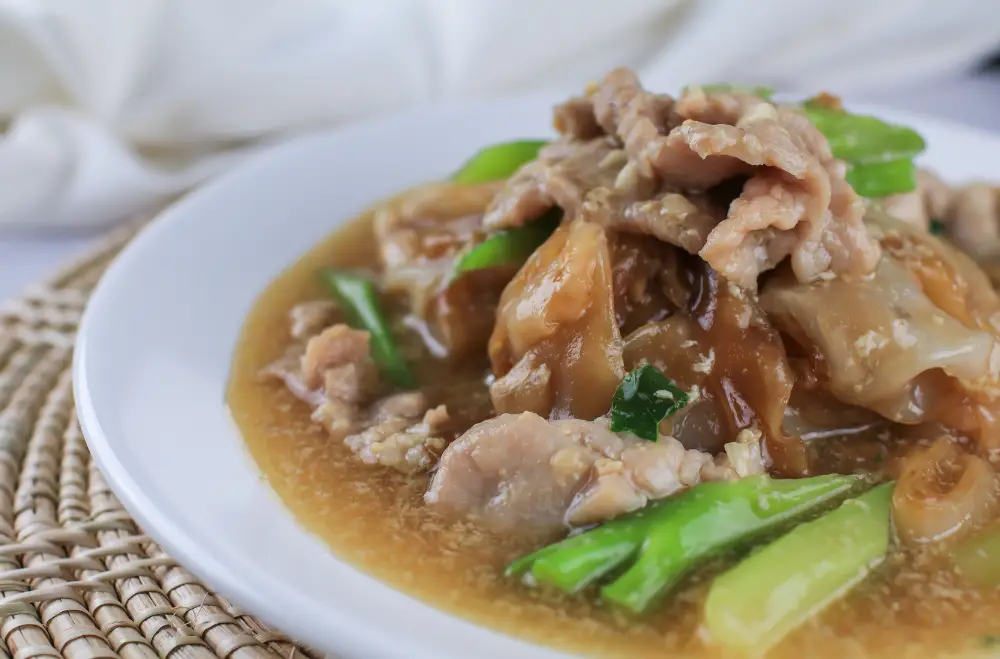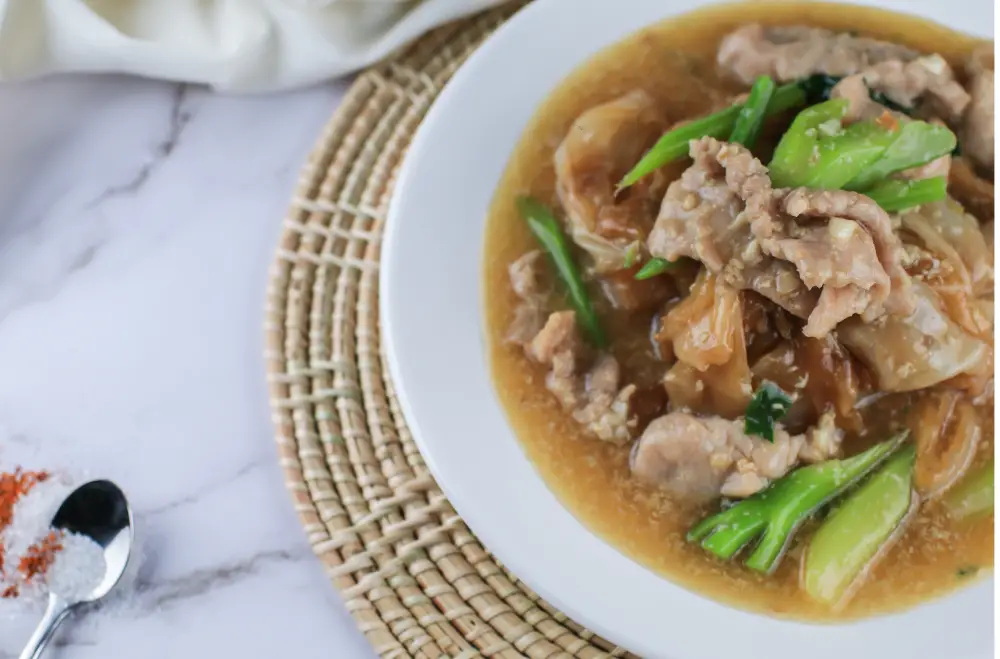Understanding Beef Soup
Introduction to Beef Soup
Beef soup, a culinary staple cherished worldwide, offers warmth, comfort, and a symphony of flavors. From the bustling kitchens of Parisian bistros to the cozy hearths of rural homes, the aroma of simmering beef fills the air, inviting all to partake in its savory delights. With its rich history and endless variations, beef soup has earned its place as a beloved dish across cultures. In this article, we delve into the essence of beef soup, exploring its origins, evolution, and the artistry behind its preparation. Join us as we embark on a journey to uncover the secrets of this timeless comfort food.
History of Beef Soup
Nutritional Value & Types of Beef Soup
Nutritional Benefits of Beef Soup
Beef soup stands out as a nutritionally dense meal, offering a wide array of essential nutrients vital for overall health and well-being. Below, we delve into the detailed nutritional profile of beef soup:
- Protein: Beef soup serves as an excellent source of high-quality protein, essential for muscle repair, growth, and overall cellular function. A single serving can provide a significant portion of the recommended daily intake of protein, making it an ideal choice for individuals looking to meet their protein requirements.
- Vitamins: Beef soup contains various vitamins that contribute to overall health. One notable example is vitamin B12, crucial for nerve function, DNA synthesis, and the formation of red blood cells. Additionally, beef soup provides other B vitamins like niacin, riboflavin, and B6, which play essential roles in energy metabolism and maintaining healthy skin, eyes, and nervous system.
- Minerals: Rich in minerals such as iron and zinc, beef soup supports various bodily functions. Iron is vital for oxygen transport in the blood and energy production, while zinc is essential for immune function, wound healing, and DNA synthesis. Incorporating beef soup into the diet can help prevent deficiencies in these crucial minerals.
- Vegetables: When beef soup is prepared with a variety of vegetables, its nutritional value is further enhanced. Vegetables like carrots, onions, celery, and tomatoes contribute additional vitamins, minerals, antioxidants, and dietary fiber. These nutrients support digestive health, reduce inflammation, and lower the risk of chronic diseases such as heart disease and certain cancers.
- Low in Calories: Despite its nutrient density, beef soup can be relatively low in calories, particularly if prepared with lean cuts of beef and minimal added fats. This makes it a satisfying yet weight-friendly option for individuals looking to manage their calorie intake while still enjoying a hearty and flavorful meal.
Types of Beef Soup
Beef soup comes in a diverse array of types and variations, each offering its own unique flavors and characteristics. Here are some popular types of beef soup:
- Clear Beef Soup: Also known as beef broth or consommé, this type of beef soup is made by simmering beef bones, meat, and aromatic vegetables in water, then straining the liquid to create a clear, flavorful broth. It serves as a versatile base for other soups and sauces.
- Beef Noodle Soup: A comforting and hearty dish, beef noodle soup features tender beef slices, vegetables, and noodles in a savory broth. Variations include Vietnamese pho, Japanese ramen, and Chinese beef noodle soup, each with its own distinct seasoning and garnishes.
- Beef Vegetable Soup: Packed with an assortment of vegetables such as carrots, potatoes, celery, and peas, beef vegetable soup is a nutritious and filling meal. The beef adds richness and depth to the broth, while the vegetables provide color, flavor, and essential nutrients.
- Beef Barley Soup: This hearty soup combines tender beef chunks, barley grains, and vegetables in a thick and flavorful broth. Barley adds a nutty flavor and chewy texture, making this soup both satisfying and nutritious.
- Beef Stew: While technically not a soup, beef stew deserves a mention for its similar preparation and comforting qualities. Slow-cooked with beef, potatoes, carrots, onions, and herbs, beef stew boasts a rich and thick broth that is perfect for dipping crusty bread or ladling over mashed potatoes.
These are just a few examples of the many delightful variations of beef soup, each offering its own delicious twist on this timeless comfort food.
Homemade Beef Soup

Here’s a simple and delicious beef soup recipe for you to enjoy:
Ingredients:
- 1 lb (450g) beef stew meat, cut into bite-sized pieces
- 1 onion, diced
- 2 carrots, sliced
- 2 celery stalks, sliced
- 2 cloves garlic, minced
- 6 cups (1.5 liters) beef broth
- 2 cups (480ml) water
- 1 can (14.5 oz / 410g) diced tomatoes
- 1 cup (180g) frozen peas
- 1 bay leaf
- 1 teaspoon dried thyme
- Salt and pepper, to taste
- Olive oil, for cooking
- Chopped fresh parsley, for garnish (optional)
Instructions:
- Heat a large pot over medium heat and add a drizzle of olive oil. Once hot, add the diced onion and cook until softened, about 3-4 minutes.
- Add the minced garlic and cook for another 1-2 minutes until fragrant.
- Add the beef stew meat to the pot and season with salt and pepper. Cook until the meat is browned on all sides, about 5-6 minutes.
- Pour in the beef broth and water, then add the diced tomatoes (including their juices), sliced carrots, celery, bay leaf, and dried thyme. Stir to combine.
- Bring the soup to a simmer, then reduce the heat to low. Cover and let the soup simmer gently for 1-2 hours, stirring occasionally, until the beef is tender.
- About 10 minutes before serving, add the frozen peas to the soup and stir to heat through.
- Taste the soup and adjust seasoning with salt and pepper if needed.
- Ladle the beef soup into bowls and garnish with chopped fresh parsley, if desired.
- Serve hot and enjoy the comforting goodness of homemade beef soup!
Feel free to customize this recipe by adding your favorite vegetables or herbs. Enjoy!
Pairing Beef Soup with Side Dishes
Beef soup pairs perfectly with a variety of side dishes, enhancing the overall dining experience with complementary flavors and textures. Here are some delicious side dish options to accompany your beef soup:
- Crusty Bread: Serve slices of crusty French baguette or hearty whole grain bread alongside your beef soup. The bread is perfect for dipping into the savory broth, soaking up every last bit of flavor.
- Salad: A crisp and refreshing salad makes a light and healthy accompaniment to beef soup. Choose a mix of fresh greens, such as lettuce, spinach, or arugula, and toss with your favorite vegetables, nuts, and a tangy vinaigrette dressing.
- Rice or Grains: Steamed rice, quinoa, or couscous can be served alongside beef soup to add heartiness and substance to the meal. These grains also help balance the flavors and provide a satisfying base for the soup.
By pairing beef soup with these side dishes, you can create a well-rounded and satisfying meal that satisfies both your taste buds and your appetite.
Beef soup holds a special place in celebratory menus, offering comfort and warmth to gatherings of family and friends. Whether it’s a festive holiday meal or a cozy dinner party, beef soup adds a touch of elegance and homeliness to any occasion. For special events, consider elevating your beef soup by incorporating premium cuts of beef, such as tenderloin or ribeye, and enhancing the flavors with aromatic herbs and spices. You can also customize the soup to fit the theme of the occasion, whether it’s a rich and hearty beef stew for a winter gathering or a light and refreshing beef noodle soup for a summer soirée. With its versatility and crowd-pleasing appeal, beef soup is sure to become a beloved favorite for all your special occasions.
Beef Soup Leftover Ideas
Transform leftover beef soup into new and exciting dishes to enjoy throughout the week. Here are some creative ideas:
- Beef and Vegetable Pot Pie: Use the leftover beef soup as a filling for a homemade pot pie. Simply transfer the soup to a pie dish, top with a layer of puff pastry, and bake until golden and bubbly.
- Beef Soup Risotto: Stir cooked rice into the leftover beef soup to create a creamy and flavorful risotto. Add Parmesan cheese and fresh herbs for an extra burst of flavor.
- Beef Soup Pasta Sauce: Blend the leftover beef soup until smooth, then use it as a base for a rich and savory pasta sauce. Serve over cooked pasta for a quick and delicious meal.
FAQs about Beef Soup
- How long does beef soup last in the fridge?
- Beef soup can typically be stored in the refrigerator for up to 3-4 days. It’s important to cool the soup quickly after cooking and store it in an airtight container to maintain freshness.
- Can I freeze beef soup?
- Yes, beef soup freezes well. Allow the soup to cool completely before transferring it to freezer-safe containers or resealable bags. It can be stored in the freezer for up to 2-3 months. Thaw overnight in the refrigerator before reheating.
- What are some vegetarian alternatives to beef soup?
- Vegetarians can enjoy delicious alternatives to beef soup by substituting beef with plant-based proteins such as tofu, tempeh, or seitan. Additionally, vegetable broth can be used as a base, and hearty vegetables like mushrooms, lentils, and beans can provide a satisfying texture and flavor.
- Is beef soup high in cholesterol?
- The cholesterol content of beef soup depends on the ingredients used and the cooking methods employed. Lean cuts of beef and minimal added fats can help reduce cholesterol levels. Additionally, incorporating plenty of vegetables and opting for homemade broth can further enhance the nutritional profile of the soup.
- Can I make beef soup in a slow cooker?
- Yes, beef soup can be easily prepared in a slow cooker. Simply combine all the ingredients in the slow cooker, set it to low or high heat depending on your preference, and let it cook for several hours until the beef is tender and the flavors have melded together beautifully. Slow cooking allows for a hands-off approach and results in a rich and flavorful soup.

